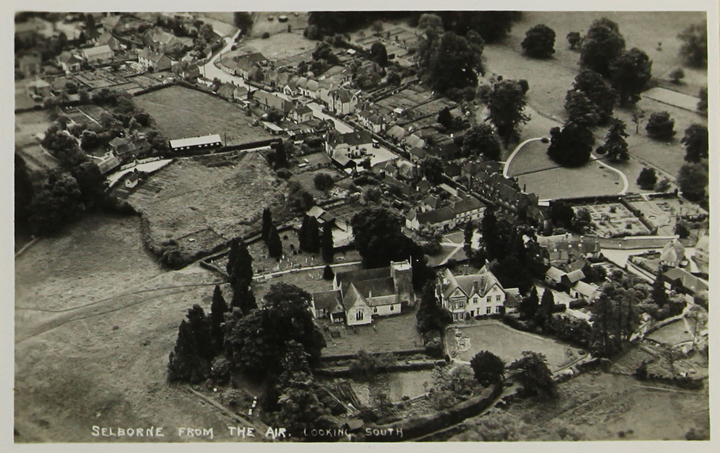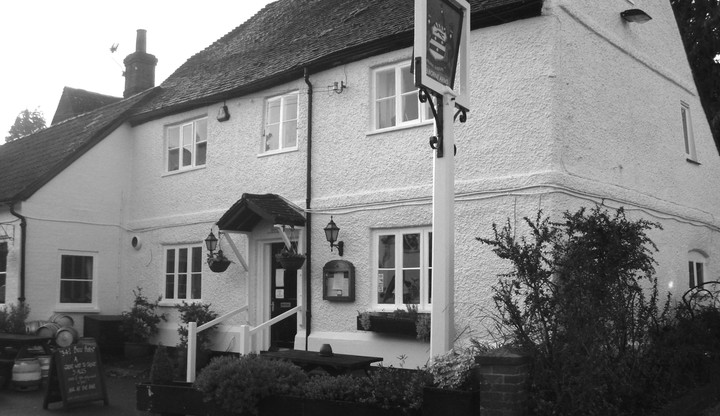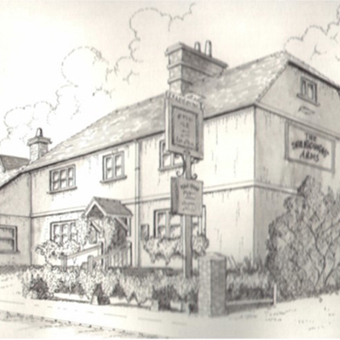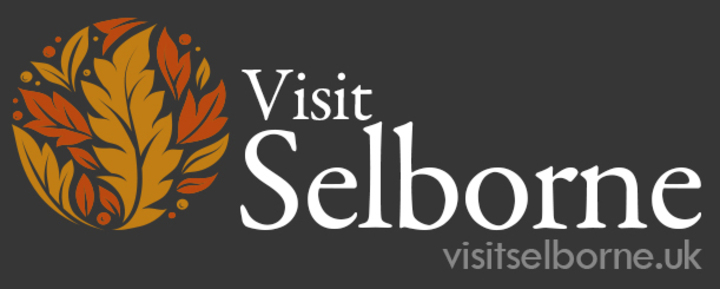About Us
Opening hours
Every day 11am - 10pm (approx)
Winter hours:
Closed 3pm - 5pm on Tuesdays, Wednesdays & Thursdays
Lunch
Served 12 noon to 2pm Tuesday to Sunday
Dinner
Served 6.30pm to 8.30pm Tuesday to Saturday
History

Gallery
On entering the Selborne Arms it is necessary to turn either left or right to enter the bars, since a massive brick chimney blocks the way ahead. The chimney serves the large fireplace in the former public bar, and a small fireplace in the former saloon bar. It also has a structural function, that of supporting the first floor and staircase.
This type of design, known as a baffle entry in view of the way the chimney appears to block access to the building, was the local tradition and is well represented in East Hampshire and West Sussex. There are several examples in the village, including Bush House - next door to the pub, and Rose Cottage opposite Bush House.
The Arms is of two storeys, symmetrical in the front elevation, giving the impression of having been built with a chimney. It appears to be timber framed, now hidden by stone cladding, and additionally at the front and west end by pebble dash. A small section of the original timber framing of the east end is exposed on the far side of the public bar where there is access to the dining area - in what was initially an extension, subsequently increased to a coach house. The break between the house and the coach house is marked not only by the timber framing but also change in floor level.
In general the evidence points to a date of about 1600 or a little later, since the brick of the fireplace and chimney is not of the 16th century. There have been many alterations to the Arms building in the succeeding centuries. The symmetry of the side elevation has been lost by the addition of an outshot at the back, covered by bridging the roof down to the first floor level. The dining area off the public bar was also an outshot, older than the coach house, from which it is separated by a vertical joint in the front brickwork. At some time a stone cladding was added, covering the timber frame. The projecting plat band or string course marking the first floor level was a popular feature on small houses in the Regency period, so we may hazard a guess that the cladding was added then, to hide the timber framing which had become very unfashionable. The removal of the small front garden and subsequent levelling made necessary the steps to the entrance, and increased the vaguely Regency appearance, spoilt of course by the pebble dash added in the 20th Century.

The original occupant of the Arms building would have been a small to middling farmer, probably describing himself in his more extravagant moments as a yeoman, but considered by his neighbours as a mere husbandman. His farm consisted of numerous acre strips scattered in the two great openfields of the village, Kingsfield and Northfield, and with rights to graze cattle and pigs, and cut wood on Selborne Common. The size of the fireplace in the public bar is testimony to the status of the first occupier, since no labourer would have had the means to provide the fuel required.
The house was held in copyhold tenure (normally for the duration of three lives - husband, wife and firstborn) from Magdalen College, which is clear evidence that the previous house on the site, before the Great Rebuilding, belonged to Selborne Priory, and was certainly medieval in age. Our forebears were very careful with building timber, so the present building probably incorporates some of the timber of its predecessor. From the 16th century the farms in the village became larger but correspondingly fewer in number. Yeomen and husbandmen were replaced by landless labourers, and many of the houses which had belonged to husbandmen or yeomen were subdivided into two dwellings for labourers. This may have been the fate of the Arms building for a short period, but in 1838 it is described as a house, probably occupied by a prosperous farmer or artisan. The presence of a malting shed in 1838 points to a farmer / maltster at the upper end of the social scale in the parish.

The first name we can definitely associate with the building dates from the 1850s; it is William Wells, a blacksmith, who held the copyhold. He does not appear to have lived in the building, but let it to Henry Maxwell and Sarah Hale. Henry Maxwell was the village grocer, his shop on the Plestor now the gallery. Sarah Hale was the widow of Hori Hale, a butcher, farmer and maltster. The butchers shop of Hori Hale is still to be seen opposite the Wakes, and it was John Hale, probably Hori’s grandfather, who sold meat and malt to Gilbert White. We may speculate that it was the connection with the Hale family that explains the existence of malting facilities, and that it was Sarah Hale and Henry Maxwell who transformed the building to a beerhouse.
The 1871 census does not mention the Arms as a beerhouse. Indeed it appears to have then been occupied by Richard Blunden, a bricklayer and founder member of the Selborne branch of the Foresters. It is first described as a beerhouse in 1878 with Charles Fyfield as landlord. Sir Roundell Palmer became Lord Selborne in 1872, so the actual establishment of the Arms as a beerhouse is between 1872 and 1878. It is perhaps a matter of surprise that Lord Selborne allowed his title to be attached to a beerhouse when there were already two fully licensed establishments in the village, the Queens Arms and the White Hart.
By the end of the last century voices were raised about excessive number of inns and public houses in some areas, leading to the ‘Congested Districts’ legislation. Selborne had one licensed premises for about every 185 persons (including children) and was therefore considered congested. The local constable, PC Chamberlain, was set to spy on all three establishments to help the magistrated decide which should be closed. He reported that the Arms was the only beerhouse (licensed to sell beer but not wine or spirits) and was much used by respectable members of the working class.
In twenty-six visits during February and March 1913 he counted 515 customers. The only drawback was the rear access invisibale to the PC from the road, thus facilitating after-hours drinking. However, the White Hart was used by less respectable members of the working class including well known poachers, and was closed. Sarah Hale sold her tenancy to Harry Smith of Alton in 1882. The Antique tenure of copyhold was converted to a modern freehold in 1884, and then bought by Gerald Hall. He sold to Courages in 1903.
In its earlier days the Selborne Arms malted its own hops and brewed its own beer. The hop kiln stood where now stands the public toilets, and the former paddock is now the children’s play area.
Much has changed since the Arms first opened; two major wars have taken their toll, and the village has suffered the flight from the country and now the return flight from the town. It has witnessed gentrification, geriatrification, and barbourisation, but has escaped the worst fate of all, keg beer. The Arms continues to meet the needs of the respectable (and the not-so-respectable) working class of Selborne for real ale and companionship.
Address
The Selborne Arms
High Street
Selborne
GU34 3JR
Telephone
01420 511247
Email
selbornearms@gmail.com
Opening hours
Every day 11am - 10pm (approx)
Winter hours:
Closed 3pm - 5pm on Tuesdays, Wednesdays & Thursdays
Lunch
Served 12 noon to 2pm Tuesday to Sunday
Dinner
Served 6.30pm to 8.30pm Tuesday to Saturday
Privacy Policy
![]() Selborne Arms GDPR Privacy Policy (606 KB)
Selborne Arms GDPR Privacy Policy (606 KB)
The Visit Selborne website contains more information about the beautiful & historic village of Selborne.

